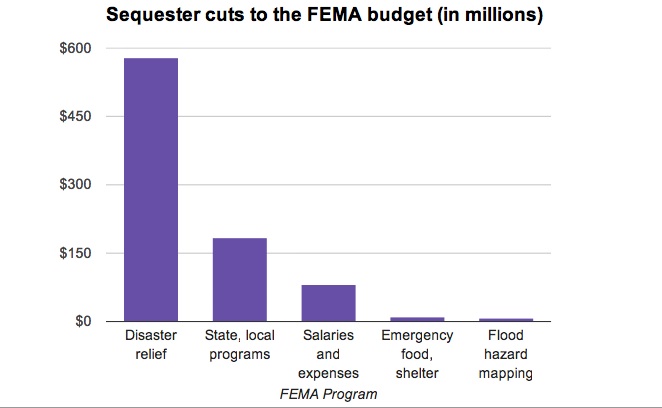As Hurricane Sandy slammed the East Coast on Monday, the historically controversial issue of funding the Federal Emergency Management Agency was center stage again.
The Washington Post's Suzy Khimm and Sarah Kliff report that FEMA, which currently is funded at $14.3 billion annually to coordinate state and local responses to natural disasters, is scheduled to lose roughly $878 million if automatic across the board spending cuts take effect in early January.
If the sequester takes effect, funding for disaster relief will be cut by $580 billion. Moreover, the $36 million in funding for states and local communities to prepare for disaster situations would drop by $3 million.

Conservative commentators including Breitbart's Joel Pollak blamed President Obama for the sequester, saying the cuts "show how far the Obama administration has been willing to go in order to preserve the idea of tax hikes on "millionaires and billionaires" rather than reaching a comprehensive grand bargain on deficit reduction that does not place additional burdens on the economy or essential services."
More than $1 trillion of long term across the board cuts in defense and domestic programs were mandated by law after a congressional super committee failed to reach agreement on a package of deficit reduction measures in late 2011.
Meanwhile, liberal leaning news outlets seized on a statement by Republican presidential nominee Mitt Romney during a June 2011 primary debate indicating he would support transferring FEMA’s disaster response responsibilities to the states – or even the private sector. The statement was unearthed by The Huffington Post's Ryan Grim.
Spending on FEMA long has been a contentious topic on Capitol Hill, and it nearly caused a government shutdown last fall, when House Republicans demanded that FEMA's funding increases be offset by cuts in other programs rather than added to the deficit. The Hill's Erik Wasson reports that “the August 2011 debt-ceiling deal had included a provision allowing disaster aid to rise above the overall spending cap, in a formula tied to previous averages. It resulted in a compromise where FEMA spending was delayed, and once fiscal 2012 began in October 2011, money flowed to FEMA without the need for offsets."
Read more at The Hill
DEBT-LIMIT SHOWDOWN LOOMS BEYOND THE FISCAL CLIFF
In true Capitol Hill fashion, congressional aides are anticipating that Congress will wait until the last minute before increasing the Treasury’s $16.4 trillion limit on borrowing.
Reuters' Richard Cowan and Rachelle Younglai report that many in Washington are predicting lawmakers will set aside the debt-ceiling negotiations and instead focus the lame duck session on averting the fiscal cliff. Many in Washington and on Wall Street doubt Congress will reach agreement on a comprehensive deficit reduction package, and instead will kick the can down the road, just narrowly avoiding sending the economy into a shallow recession.
"A lot of people [in Congress] don't want it [the debt-limit increase] to be part of the lame duck," a congressional aide told Reuters. "For many people, the situation is complicated enough as it is" with the budget and tax decisions. "So why not take one component out of the equation."
FISCAL CLIFF INVESTMENT STRATEGY
Robert Morris, a Wall Street veteran and small business executive, suggests investing in low-volatility investment funds as a strategy to combat the looming fiscal cliff.
Morris explains that if the massive tax increases and spending cuts take effect in January and the economy tumbles over the cliff, market volatility will soar. Sothe best way to protect against harmful effects of higher volatility is to invest in a low-volatility ETF, or investment fund, which is designed for investors looking to avoid volatility and limit the downside in their portfolios while still investing in equities. According to Morris, low volatility products have proven their ability to deliver superior risk adjusted returns.

